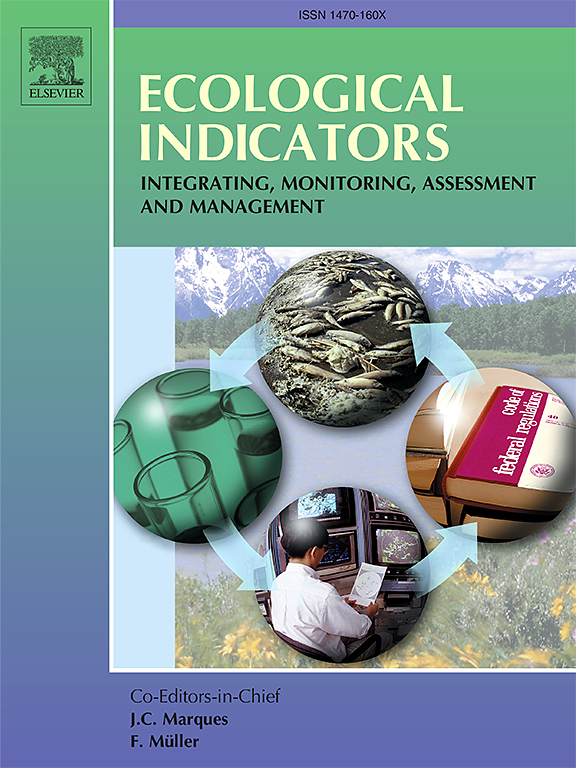长江经济带生态文明时空异质性研究
IF 7
2区 环境科学与生态学
Q1 ENVIRONMENTAL SCIENCES
引用次数: 0
摘要
生态文明建设体现了中国的可持续发展战略,体现了人与自然的和谐共生。长江经济带(YREB)是这一倡议的关键区域。尽管已有研究对长江经济带生态文明发展过程中的时空分异和子系统协调进行了评估,但对其区域发展趋势、城市尺度动态和发展模式异质性的探讨仍不足。本文以118个YREB城市为研究对象,提出了一种将遗传算法与动态偏差最大化模型(GA-DM)相结合的权重计算方法,以保证权重的客观性。生态文明进步指数(ECPI)是在多标准决策理论的基础上建立的,是一个涵盖环境、经济、社会三个维度的三维指标体系。该系统结合了遥感数据,包括净初级生产力、夜间照明指数和温室气体排放数据,以解决传统数据的局限性。采用Getis-Ord Gi*、耦合协调度和RFA-SHAP方法,对2013 - 2022年的时空分异、耦合协调趋势和关键影响因素进行了分析。结果表明:(1)ECPI显著增加,但随时间的推移,增长率呈“东高西低”的波动和下降趋势,东西差距不断扩大;(2)耦合协调水平有所提高,区域差异逐渐缩小,但西南边境城市耦合协调水平相对滞后;③影响长江经济带生态文明发展的关键因素最初以经济子系统为主导,随着社会子系统的增强和环境子系统的减弱,经济子系统的主导作用逐渐减弱;④城市生态文明建设的主要驱动因素演变明显,东部经济城市向经济-环境驱动型转变,中部城市向混合型转变,西部城市向环境驱动型转变,区域异质性明显。这些驱动因素在整个长江经济带表现出不同的时空影响。这些发现揭示了关键影响因素和区域差异,为制定差别化政策提供了依据。本文章由计算机程序翻译,如有差异,请以英文原文为准。
Spatiotemporal heterogeneity of the ecological civilization in the Yangtze River economic belt
The pursuit of the ecological civilization embodies the strategy of China for sustainable development and the harmonious coexistence of humans and nature. The Yangtze River Economic Belt (YREB) serves as a critical region for this initiative. Although prior studies have assessed spatiotemporal differentiation and subsystem coordination in the ecological civilization development process in the YREB, revealing regional trends, municipal-scale dynamics and heterogeneity in development patterns remain underexplored. In this study, 118 YREB cities are explored, and a novel weight calculation method that combines a genetic algorithm with a dynamic deviation maximization model (GA-DM) is introduced to ensure objectivity. The ecological civilization progress index (ECPI) is established on the basis of Multicriteria Decision-Making (MCDM) theory, and a three-dimensional indicator system covering environmental, economic, and social dimensions is applied. The system incorporates remote sensing data, including net primary productivity, nighttime light index, and greenhouse gas emission data, to address traditional data limitations. The Getis-Ord Gi*, coupling coordination degree, and RFA-SHAP methods are applied to examine spatiotemporal differentiation, coupling coordination trends, and key influencing factors from 2013 to 2022. The results revealed that (1) the ECPI increased significantly, but the growth rates fluctuated and declined over time, revealing a “higher in the east, lower in the west” pattern, with a widening east-west gap; (2) the coupling coordination levels improved, with narrowing regional disparities, although these levels lagged in southwestern border cities; (3) the key factors influencing ecological civilization development in the YREB were initially led by economic subsystem, with this influence diminishing as the social subsystem gained strength and the environmental subsystem remained weak; and (4) primary drivers of ecological civilization progress in cities evolved distinctly, with shifts toward economy-environment-driven factors in eastern economic cities, mixed-type factors in central cities, and environment-driven factors in western cities, revealing pronounced regional heterogeneity. These drivers exhibit varied temporal and spatial impacts across the YREB. These findings reveal key influencing factors and regional disparities, providing a basis for formulating differentiated policies.
求助全文
通过发布文献求助,成功后即可免费获取论文全文。
去求助
来源期刊

Ecological Indicators
环境科学-环境科学
CiteScore
11.80
自引率
8.70%
发文量
1163
审稿时长
78 days
期刊介绍:
The ultimate aim of Ecological Indicators is to integrate the monitoring and assessment of ecological and environmental indicators with management practices. The journal provides a forum for the discussion of the applied scientific development and review of traditional indicator approaches as well as for theoretical, modelling and quantitative applications such as index development. Research into the following areas will be published.
• All aspects of ecological and environmental indicators and indices.
• New indicators, and new approaches and methods for indicator development, testing and use.
• Development and modelling of indices, e.g. application of indicator suites across multiple scales and resources.
• Analysis and research of resource, system- and scale-specific indicators.
• Methods for integration of social and other valuation metrics for the production of scientifically rigorous and politically-relevant assessments using indicator-based monitoring and assessment programs.
• How research indicators can be transformed into direct application for management purposes.
• Broader assessment objectives and methods, e.g. biodiversity, biological integrity, and sustainability, through the use of indicators.
• Resource-specific indicators such as landscape, agroecosystems, forests, wetlands, etc.
 求助内容:
求助内容: 应助结果提醒方式:
应助结果提醒方式:


